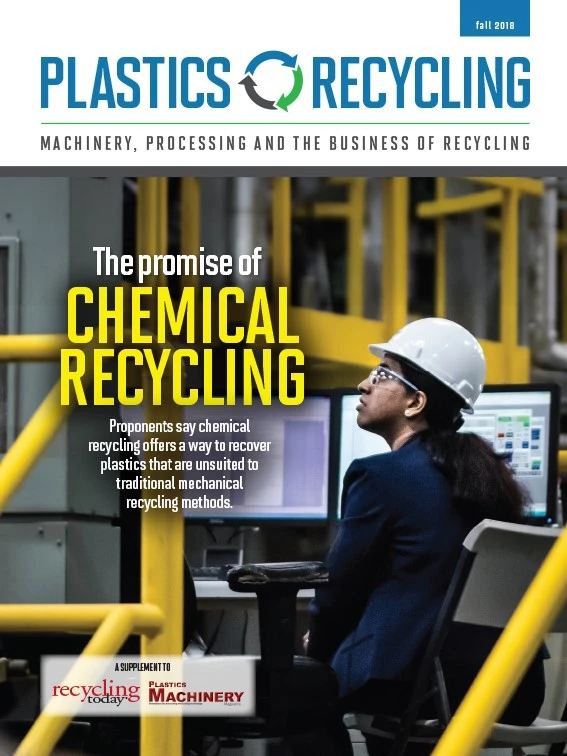
A new shredder has helped a company in São Paulo improve its efficiency.
The company, which declined to be identified publicly, reached out to Lindner-Recyclingtech GmbH, Spittal an der Drau, Austria, for an upgrade. The customer runs its own plastics recycling operation, mostly handling postconsumer, low-density polyethylene (LDPE) film. The recycling operation’s output is more than 4,400 pounds per hour.
Frederico Hartmann, the sales director for Lindner’s plastics division in Latin America, says the customer told Lindner it wasn’t happy with the performance of its washing line. He oversaw the project for Lindner.
“We faced immediately one very clear problem on the very beginning of the line: Their old supplier had installed a double-shaft shredder as [the] primary shredder for the washing line,” Hartmann says. “This mistake led to the creation of a bottleneck since this machine type cannot guarantee a homogeneous output size in order to guarantee a proper washing of the material down the stream.”
He likened the situation to using a sports car around a farm: It’s just not the right choice for the terrain.
Hartmann says the double-shaft preshredders are not appropriate for plastics recycling unless the goal is merely to shrink volume, which is typically done to reduce transportation costs. The problem is that the two shafts are too distant from each other, “easily leading to material passing without cutting at all,” he adds.
Another problem with the two-shaft setup was that the machine normally didn’t have a screen in place below the shaft, so the output size wasn’t homogenous.
Hartmann says, “Walking around the plant, we could see very large scraps of material, which was an even more clear indication of the poor shredding solution that was in place by then.”
When used with washing lines, he says preshredders must deliver a particle size with 95 percent of the material smaller than 60 millimeters (roughly 2.3 inches). Hartmann says, “This will help on the proper washing, separation and drying of the plastic flakes.”
The double-shaft preshredder was not only contributing to poor quality in the washing process “but also causing … a lot of work in order to get that material eventually dry,” he adds.
Lindner’s solution was to replace the double-shaft preshredder with a single-shaft Micromat 2000, installed in front of the existing wash line. “We were sure that this simple solution would help improve the results of the washing line,” Hartmann says.
The Micromat 2000 has a set of 68 knives with 65-millimeter (roughly 2.5-inch) blades, a configuration that Hartmann says reduces the generation of fines in the shredding process and cuts down on the percentage of material loss on the washing line.
The 60-millimeter screen size ensures a homogenous particle size.
For this application, Lindner installed a machine with a gearbox transmission as opposed to a belt-driven transmission.
The Micromat 2000 features flat, reversible knives that can be rotated four times. Hartmann says other suppliers use concave knives that can be reused only twice.
As an added benefit, the washing line’s downtime has been reduced, thanks to the preshredder’s robust engineering, low wear and easy access to the cutting chamber.
Hartmann says downtime also could be reduced because of the longer lifetime of the knives.
With the machine, it’s easy to change knives and adjust counter knives because of the hydraulic maintenance door. And screens are easy to access and change because of the machine’s hydraulically operated design.
An internal pusher that ensures continuous shredding further contributes to the machine’s efficiency.
The Micromat 2000 comes with rotor-protection welding, designed to reduce rotor wear and substantially increasing the rotor’s lifetime when running contaminated material. It is equipped with a torque-limiting safety clutch, providing drive protection.
The model has a 132-kilowatt motor and 79.7-inch-long rotor, which moves at 120 rpm. The preshredder’s opening measures about 9.2 feet by 7.9 feet, with a filling height of about 8.5 feet. In all, the cutting zone comprises about 48.4 square feet.
For more information:
Lindner Recyclingtech America LLC, 800-235-1391, www.l-rt.com

Explore the November 2018 Plastics Recycling Issue
Check out more from this issue and find your next story to read.
Latest from Recycling Today
- Orion ramping up Rocky Mountain Steel rail line
- Proposed bill would provide ‘regulatory clarity’ for chemical recycling
- Alberta Ag-Plastic pilot program continues, expands with renewed funding
- ReMA urges open intra-North American scrap trade
- Axium awarded by regional organization
- Update: China to introduce steel export quotas
- Thyssenkrupp idles capacity in Europe
- Phoenix Technologies closes Ohio rPET facility





